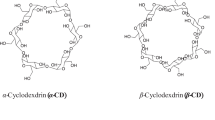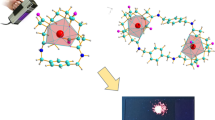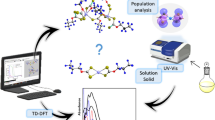Abstract
Photostability of B(III), Zn(II), Cd(II) complexes with monoiodo- and dibromosubstituted dipyrromethenes [BF2L] and [ML2] in benzene and cyclohexane solutions is studied. It is found that the mechanism of destruction of the dyes under UV radiation is based on participation of singlet oxygen generated by the excited triplet state of the dye. Singlet oxygen enters the oxidation reactions of the pigment molecules leading to accumulation of colorless products based on di-, monopyrrol, and smaller fragments. Initial stages of the process include the reactions of dehalogenation of the dye molecules and are accompanied by enhancement of the fluorescence of the formed alkyl-substituted dipyrromethenates. The photostability of boron complexes [BF2L] is up to 32 times higher as compared to that of [ZnL2] and [CdL2]. The replacement of 4-iododipyrromethene ligands in [BF2L] and [ML2] by 5,5'-or 4,4'-dibromo-substituted ligands increases photostability of the dyes. The stability of the dyes against UV irradiation substantially decreases in benzene with respect to cyclohexane due to enhancement of polarization of the chromophore systems of dipyrromethene ligands because of their solvation with benzene (π–π-stacking).
Similar content being viewed by others
References
Awuah, S.G., Polreis, J., Biradar, V., and You, Y., Org. Lett., 2011, vol. 13, p. 3884. doi 10.1021/ol2014076
Pang, W., Zhang, X.F., Zhou, J., Yu, C., Hao, E., and Jio, L., Chem. Commun., 2012, vol. 48, p. 5437. doi 10.1039/C2CC30915G
Lim, S., Thivierge, C., Nowak-Sliwinska, P., Han, J., Van den Bergh, H., Wagnieres, G., Burgess, K., and Lee, H., J. Med. Chem., 2010, vol. 53, p. 2865. doi 10.1021/jm901823u
Lincoln, R., Durantini, A.M., Greene, L.E., Marthnez, S.R., Knox, R., Becerra, M.C., and Cosa, G., Photochem. Photobiol. Sci., 2017, vol. 16, p. 178. doi 10.1039/c6pp00166a
Ra, C., Xu, X., Raymond, S.B., Ferrara, B.J., Neal, K., Bacskai, B.J., Medarova, Z., and Moore, A., J. Am. Chem. Soc., 2009, vol. 31, p. 15257. doi 10.1021/ja9047043
Boyer, J.H., Haag, A.M., Sathyamoorthi, G., Soong, M.L., Thangaraj, K., and Pavlopoulos, T., Heteroatom Chem., 1993, vol. 4, p. 39. doi 10.1002/XK.520040107.
Nuraneeva, E.N., Guseva, G.B., Antina, E.V., Berezin, M.B., and V’yugin, A.I., J. Lumin., 2016, vol. 170, p. 248. doi 10.1016/j.jlumin.2015.10.061
Nuraneeva, E.N., Guseva, G.B., Antina, E.V., Kuznetsova, R.T., Berezin, M.B., and V’yugin, A.I., Russ. J. Gen. Chem., 2016, vol. 86, no. 4, p. 840. doi 10.1134/S1070363216040149
King, E.R. and Betley, T.A., J. Am. Chem. Soc., 2009, vol. 131, p. 14374. doi 10.1021/ja903997a
Plavskii, V.Y., Mostovnikov, V.A., Tret’yakova, A.I., and Mostovnikova, G.R., J. Appl. Spectr., 2008, vol. 75, p. 407. doi 10.1007/s10812-008-9061-2
Yutanova, S.L., Berezin, M.B., Kuznetsova, R.T., Asenova, Y.V., and Tel’minov, E.N., Russ. Phys. J., 2013, vol. 56, no. 3, p. 264. doi 10.1007/s11182-0130-0025-5
Guseva, G.B., Antina, E.V., Beresin, M.B., V’yugin, A.I., and Nuraneeva, E.N., Russ. J. Gen. Chem., 2013, vol. 83, no. 8, p. 1571. doi 10.1134/S1070363213080161
Berezin, B.D., Coordination Compounds of Porphyrins and Phthalocyanines, Toronto: John Wiley, 1981.
Guseva, G.B., Antina, E.V., Ksenofontov, A.A., and Nuraneeva, E.N., J. Struct. Chem., 2016, vol. 57, p. 25. doi 10.1134/S0022476616010042
Berezin, B.D. and Enikolopyan, N.S., Metalloporfiriny (Metalloporphyrins), Moscow: Nauka, 1988.
Antina, E.V. and Rumyantsev, E.V., Khimiya bilirubina i ego analogov (Chemistry of Bilirubin and Its Analogues), Moscow: Krasand, 2009.
Kautsky, H., Trans. Faraday Soc., 1939, vol. 35, p. 216. doi 10.1039/TF9393500216
Investigations of Rates and Mechanisms of Reactions, Techniques of Chemistry, Hammes, G.G., Ed., New York: Wiley Interscience, 1974, vol. 6, part II, 3rd ed.
Wang, X.M., Zhou, Y.F., Yu, W.T., Wang, C., Fang, Q., Jiang, M.H., Lei, H., and Wang, H.Z., J. Mater. Chem., 2000, vol. 10, p. 2698. doi 10.1039/B006764O
Author information
Authors and Affiliations
Corresponding author
Additional information
Original Russian Text © E.N. Nuraneeva, Е.V. Antina, G.B. Guseva, М.B. Berezin, А.I. V’yugin, 2018, published in Zhurnal Obshchei Khimii, 2018, Vol. 88, No. 6, pp. 992–999.
Rights and permissions
About this article
Cite this article
Nuraneeva, E.N., Antina, E.V., Guseva, G.B. et al. Effect of Structure and Medium on Photostability of Halogenated Boron(III), Zinc(II), and Cadmium(II) Dipyrromethenates. Russ J Gen Chem 88, 1172–1179 (2018). https://doi.org/10.1134/S1070363218060208
Received:
Published:
Issue Date:
DOI: https://doi.org/10.1134/S1070363218060208




